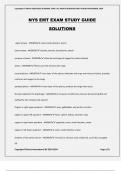Copyright © KAYLIN 2024/2025 ACADEMIC YEAR. ALL RIGHTS RESERVED FIRST PUBLISH NOVEMBER, 2024
NYS EMT EXAM STUDY GUIDE
SOLUTIONS
upper airway - ANSWER✔✔-nasal cavity, pharynx, larynx
lower airway - ANSWER✔✔-trachea, bronchi, bronchioles, alveoli
purpose of aveoli - ANSWER✔✔-allow the exchange of oxygen for carbon dioxide
pluera - ANSWER✔✔-fibrous sac that encloses the lungs
visceral pluera - ANSWER✔✔-inner layer of the pleura, lubricates the lungs and reduces friction, provides
nutrients and oxygen to the lungs
partietal pleura - ANSWER✔✔-outer layer of the pleura, protects the lungs from injury
During inspiration the diaphragm - ANSWER✔✔-increases intrathoracic pressure by becoming flat and
pulling the ribs outward and upward
Organs in right upper quadrant - ANSWER✔✔-Liver, gallbladder, and portion of colon
organs in upper left quadrant - ANSWER✔✔-heart, spleen, kidney, stomach, lung
organs in right lower quadrant - ANSWER✔✔-appendix, colon, small intestine, ureter
organs in left lower quadrant - ANSWER✔✔-colon, small intestine, ureter
Sections of the spinal column - ANSWER✔✔-cervical (7), thoracic (12), lumbar (5), sacral (5), coccygeal
(4)
Copyright ©Stuvia International BV 2010-2024 Page 1/21
,Copyright © KAYLIN 2024/2025 ACADEMIC YEAR. ALL RIGHTS RESERVED FIRST PUBLISH NOVEMBER, 2024
Vertebrae: cervical - ANSWER✔✔-7
vertebrae: thoracic - ANSWER✔✔-12
vertebrae: lumbar - ANSWER✔✔-
vertebrae: sacrum - ANSWER✔✔-5
vertebrae: coccyx - ANSWER✔✔-4
unique part of infants head - ANSWER✔✔-fontanels
sections of the brain - ANSWER✔✔-cerebrum (high functions), cerebellum (balance), brain stem
(automatic functions)
flexion and extension - ANSWER✔✔-flexion = forward This action occurs at many joints and always
brings the bones that make up a joint closer together, or closes the joint. Extension is the opposite of
flexion, which means it lessens the angle between the two bones or opens the joint
supine vs prone - ANSWER✔✔-face up/face down
proximal vs distal - ANSWER✔✔-Proximal then refers to something closer to the torso while distal refers
to parts and places away from the torso
knee is proximal to ankle
wrist is distal to elbow
tendons - ANSWER✔✔-Connect muscle to bone
Copyright ©Stuvia International BV 2010-2024 Page 2/21
, Copyright © KAYLIN 2024/2025 ACADEMIC YEAR. ALL RIGHTS RESERVED FIRST PUBLISH NOVEMBER, 2024
Ligament - ANSWER✔✔-Connects bone to bone
joint - ANSWER✔✔-A place in the body where two bones come together
cartilage - ANSWER✔✔-A connective tissue that is more flexible than bone and that protects the ends of
bones and keeps them from rubbing together.
respiratory system - ANSWER✔✔-mouth, nose, oropharynx, nasopharynx, epiglottis, trachea, bronchi (3
on right, 2 on left), bronchioles, alveoli, diaphragm
upper airway - ANSWER✔✔-nasal cavities, oral cavity, pharynx (nasopharynx, oropharynx, hypopharynx),
larynx
lower airway - ANSWER✔✔-trachea, bronchi, bronchioles, alveoli
A&P heart: mechanical - ANSWER✔✔-atria, ventricles, tricuspid valve, mitral valves
A&P heart: electrical - ANSWER✔✔-SA node, AV node, bundle of HIS, bundle branches, purkinje fibers
A&P circulatory system - ANSWER✔✔-veins, arteries, capillaries
pulmonary veins - ANSWER✔✔-Deliver oxygen rich blood from the lungs to the left atrium
pulmonary artery - ANSWER✔✔-artery carrying oxygen-poor blood from the heart to the lungs
Path of blood through the heart - ANSWER✔✔-1.superior and inferior vena cava (from the body)
2.right atrium
3.tricuspid valve
4.right ventricle
Copyright ©Stuvia International BV 2010-2024 Page 3/21




